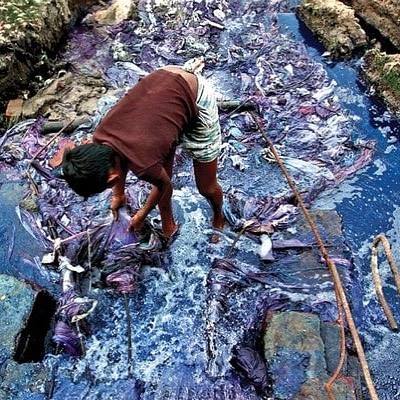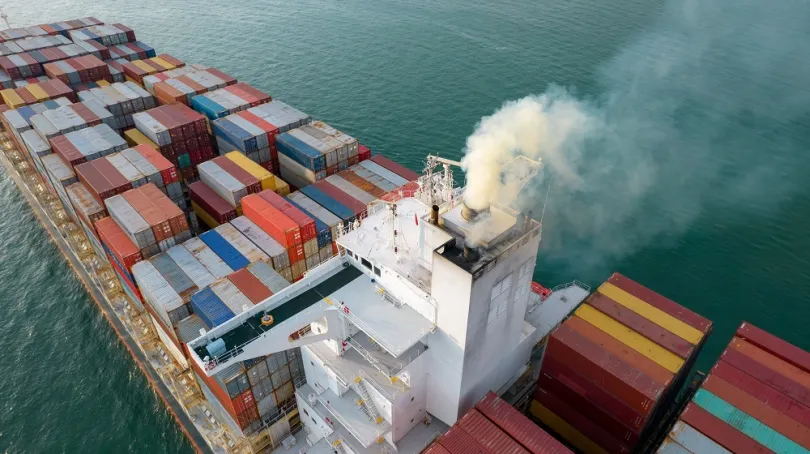Fast Fashion - The Journey of Winter Jumper & A Bobble Hat
Fast fashion refers to cheap, trendy clothing that samples ideas from the catwalk or celebrity culture and turns them into garments in high street stores at lightning speed to meet consumer demand.
The idea is to get the newest styles on the market, so shoppers can purchase them when in style & discard them after a few wears.
Imagine this winter you buy a lovely jumper and bobble hat.... Let's take a little look at these garments' journey.


What are fast fashion items made of?
- Cheap fabrics like polyester, polyurethane, rayon, spandex, nylon, made from non-renewable fossil fuels - petrochemical textiles. They require an immense amount of energy and resources to be produced.
- Cheap, toxic textile dyes - Today, 90% of our clothes are dyed synthetically and require incredible amounts of water and often toxic chemicals in production. The majority of this water returns to nature as a “toxic chemical soup”, laden with residual dyes, hazardous chemicals, heavy metals, microfibres, and mordants. Tis then ingested by land & marine life though the food chain to devastating effect.
- Faux Fur - let's consider the furry bobble on your hat - numerous scandals reveal that real fur, including cat and dog fur, is often being passed off as faux fur to unknowing shoppers. The truth is that there is so much real fur being produced under terrible conditions in fur farms that it’s become cheaper to produce and buy than faux fur!

How are they made?
Items of fast fashion generally come from underserved communities, where unfortunately people are often being used like a machine and do not have any rights.
Slavery that happened in history is still here it has just changed its form.
Further down the supply chain, the farmers may work with toxic chemicals and brutal practices that can have devastating impacts on their physical and mental health.
Let's take an example from Nepal
Six undocumented 9 year olds from a small village that cannot be found on maps, in a tiny room, where they work, eat and sleep. There is no running water so they clean their hands with kerosene, eat their meagre meals with dirty hands polluting their food with threads and chemicals. Sleeping at night on materials and the clothes that they have been making. They work from 4am to 11pm
If these girls do not get their quota of garments made they will not be paid for the whole week. And their pay is less than $2 a day.
Each worker only does one specific section of the jumper/ hat. So they are not learning the skill of making a whole garment.

Your garments' journey
Now your hat and jumper are shipped to UK, over 7000 km.
Fast fashion shipping
Shipping is responsible for over a tenth of transport CO2 emissions and is a major source of air pollution.
Shipping also contributes to climate change through emissions of Black Carbon, tiny black particles, produced by combustion of marine fuel. The highest amounts of black carbon particles are produced by ships burning heavy fuel oil. Black carbon accounts for 21% of CO2 equivalent from ships, making it the second most important driver of shipping’s climate impacts after carbon dioxide. Currently there are no regulations controlling black carbon emissions from shipping.

Now your items arrive at a warehouse in the UK
Here employees are paid as little as £3.50 an hour. 12 hour shifts in temperatures up to 32 degrees.
Staff cover up to 8 miles an hour, expected to reach a target of 130 items an hour, more than 2 a minute even though these items can be spread all around the warehouse.
Claims of racism and sexual harassment are common.
Callouts to ambulances happen often, ¾ of these resulting in employees taken to hospital after fainting or falling unconscious.
Getting to your door
Finally after more transport pollution a package arrived to your doorstep.
You pull on your jumper and pop your hat on your head.
Many of the chemicals used to manufacture these fabrics are toxic and some are even considered carcinogenic.
Since human skin is porous, these microscopic chemicals are able to easily seep into your skin and cause dire health conditions.
Then you put them in wash, they shed microplastics. Out of the 8 million metric tonnes of plastic that ends up in our oceans every year, about 1.5 million tonnes is "microplastic"

So why would you buy fast fashion clothes?
Fast fashion makes us believe we need to shop more and more to stay on top of trends, creating a constant sense of need and ultimate dissatisfaction.
Fast fashion can impact consumers themselves, encouraging a “throw-away” culture because of both the built-in obsolescence of the products and the speed at which trends emerge.
It is confusing – all left for us to figure out as consumers, people don’t know what decisions to make, overwhelming.
The average Irish person spends €850 a year in the clothing retail sector – about €70 a month

How to recognise a fast fashion brand
- Brands which have thousands of styles, touching on all the latest trends.
- Extremely short turnaround time between when a trend or garment is seen on the catwalk or in celebrity media and when it hits the shelves.
- Offshore manufacturing where labour is the cheapest, with the use of workers on low wages without adequate rights or safety and complex supply chains with poor visibility beyond the first tier.
- A limited quantity of a particular garment—this is an idea pioneered by Zara. With new stock arriving in store every few days, shoppers know if they don’t buy something they like, they’ll probably miss their chance.
- Cheap, low quality materials like polyester, causing clothes to degrade after just a few wears and get thrown away.
No matter what environmental/sustainable buzzwords they are using - Unless they are stating explicitly that they are paying a living wage – then there is human slavery involved and pollutants etc.

What can we do?
If we as consumers begin to reject the exploitative nature of fast fashion, there’ll be no market for it.
- Remember that someone somewhere made your clothing and their life has value.
- Wear what you have in your wardrobe,
- Repair or take care of your clothing
- Buy second-hand
- Buy from independent retailers that indicate living wage, recycled materials
- Send customer emails to ask questions –they get answered. You're investing your money, you have a right to have your questions answered
- Arrange swaps with friends or swapping events.
- Use websites to get informed & apps to buy second hand – goodonyou, thenuwardrobe, depop.

ESG stands for Environmental Social Governance in the private sector and it aims to embed all 17 Sustainable Development Goals into an organisation. Become an ESG Leader with our 5 month Online Educational Programme. And don't forget to subscribe to our newsletter.
Thank you for reading today.
The Fifty Shades Greener Team
💚



